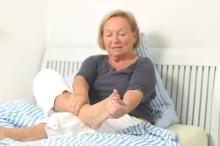Osteoarthritis of the foot takes one of two forms: isolated disease of the first metatarsophalangeal joint or more extensive disease of that and several other joints of the midfoot, researchers reported online in Arthritis Care & Research.
The latter, known as polyarticular foot osteoarthritis (OA), disproportionately affects women, is associated with worse pain and disability, compared with localized disease, and tends to co-occur with nodal hand OA, said Trishna Rathod of Keele University, Staffordshire, England, and her associates.
Studies of OA phenotypes have yielded targeted treatments (Ann Intern Med. 2009;150[10]:661-9andOsteoarthritis Cartilage. 2014;22[suppl S431]) for other joints, but had not yet characterized foot OA, the researchers said. Therefore, they surveyed 533 adults who reported foot pain in the prior year and scored radiographs of their first metatarsophalangeal, first and second cuneometatarsal, navicular first cuneiform, and talonavicular joints. The patients did not have psoriatic or rheumatoid arthritis and averaged 65 years of age (Arthritis Care Res. [Hoboken] 2015 Aug. 3. doi: 10.1002/acr.22677).
In all, 15% of patients had polyarticular foot OA, 22% had isolated OA of the first metatarsophalangeal joint, and 64% had no or minimal foot arthritis, the investigators reported. About 77% of patients with polyarticular disease were women, compared with approximately half of those in the other groups (P = .001). After the researchers controlled for age and sex, polyarticular disease was significantly linked to nodal hand OA (P = .04), higher body mass index (P = .002), worse scores on a 10-point foot pain scale (6 vs. 4.9 and 5.2 for the other classes; P = .02), and worse pain and disability scores on the Manchester Foot Pain and Disability Index (P = .002 and .007), they said.
“As is the case for OA at other small joint sites, particularly the hands, patterning of individual joint involvement in radiographic foot OA is polyarticular and strongly symmetrical,” the researchers concluded. “Patterns of joint involvement in radiographic foot OA have indicated a distinction between individuals with isolated [first] metatarsophalangeal joint OA and those with a more widespread form of OA ... which also includes one or both first metatarsophalangeal joints.”
The Arthritis Research UK Programme Grant and the West Midlands North CLRN supported the work. The investigators declared no competing interests.


